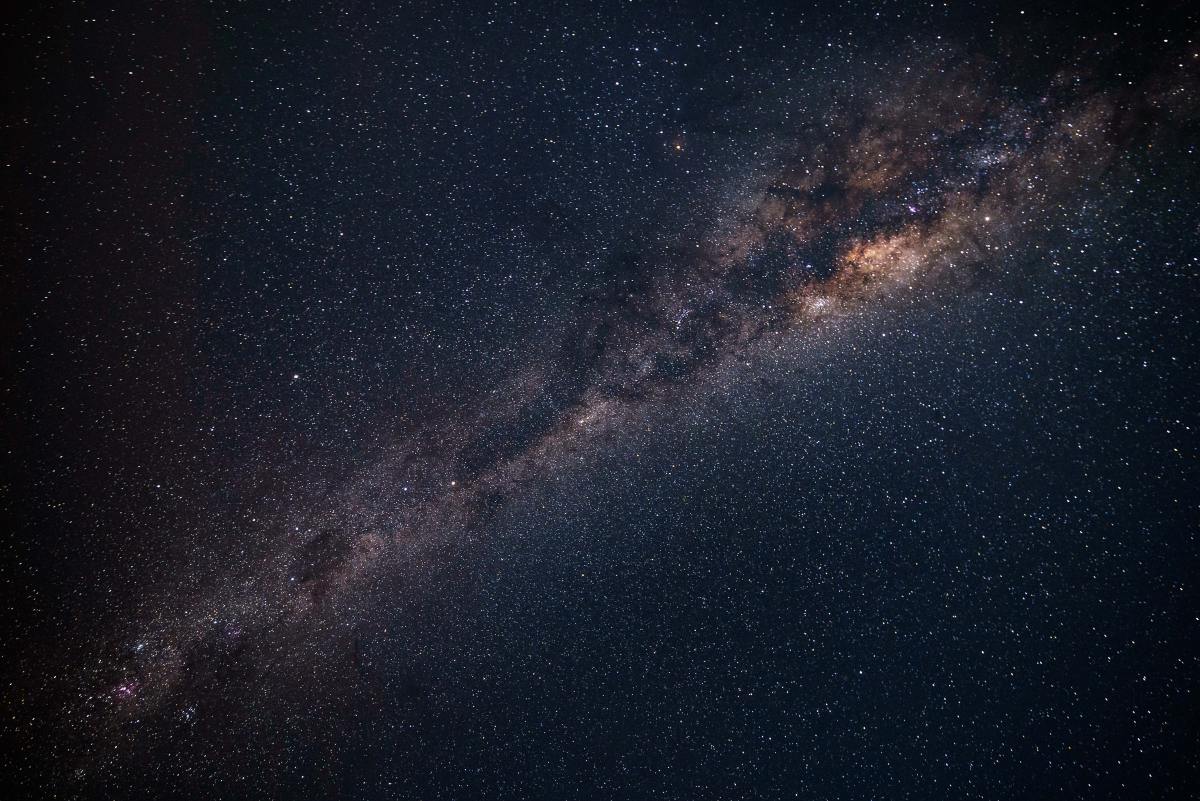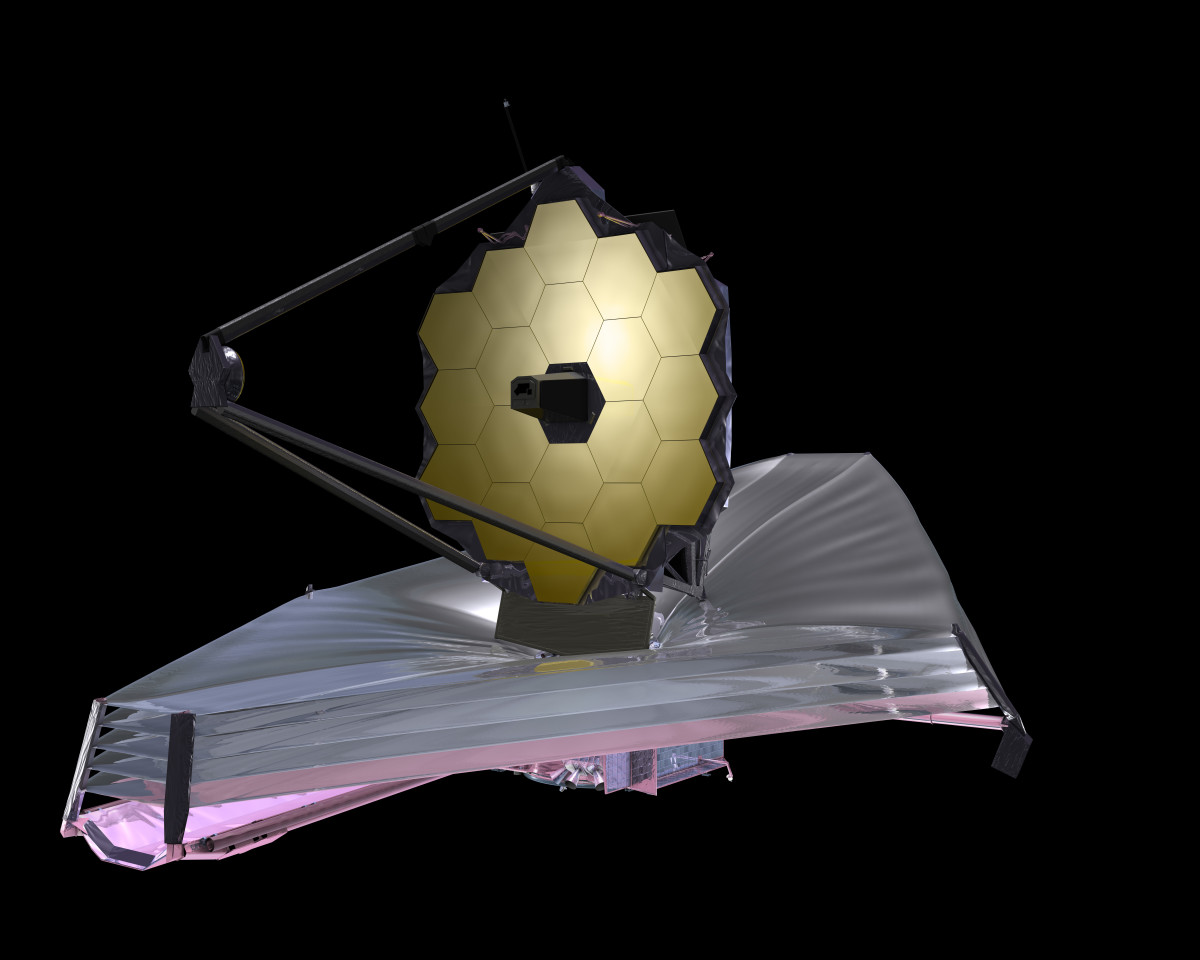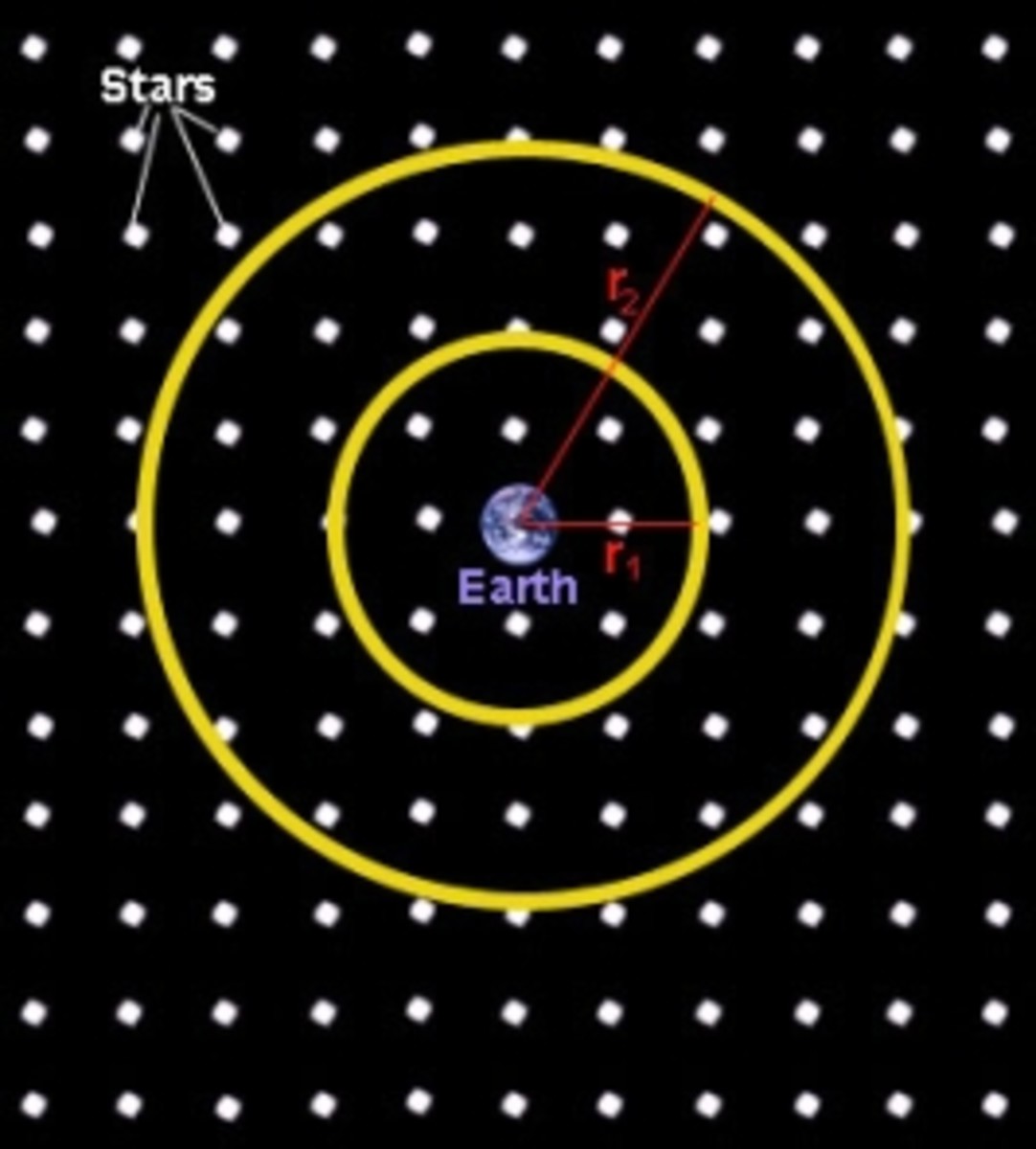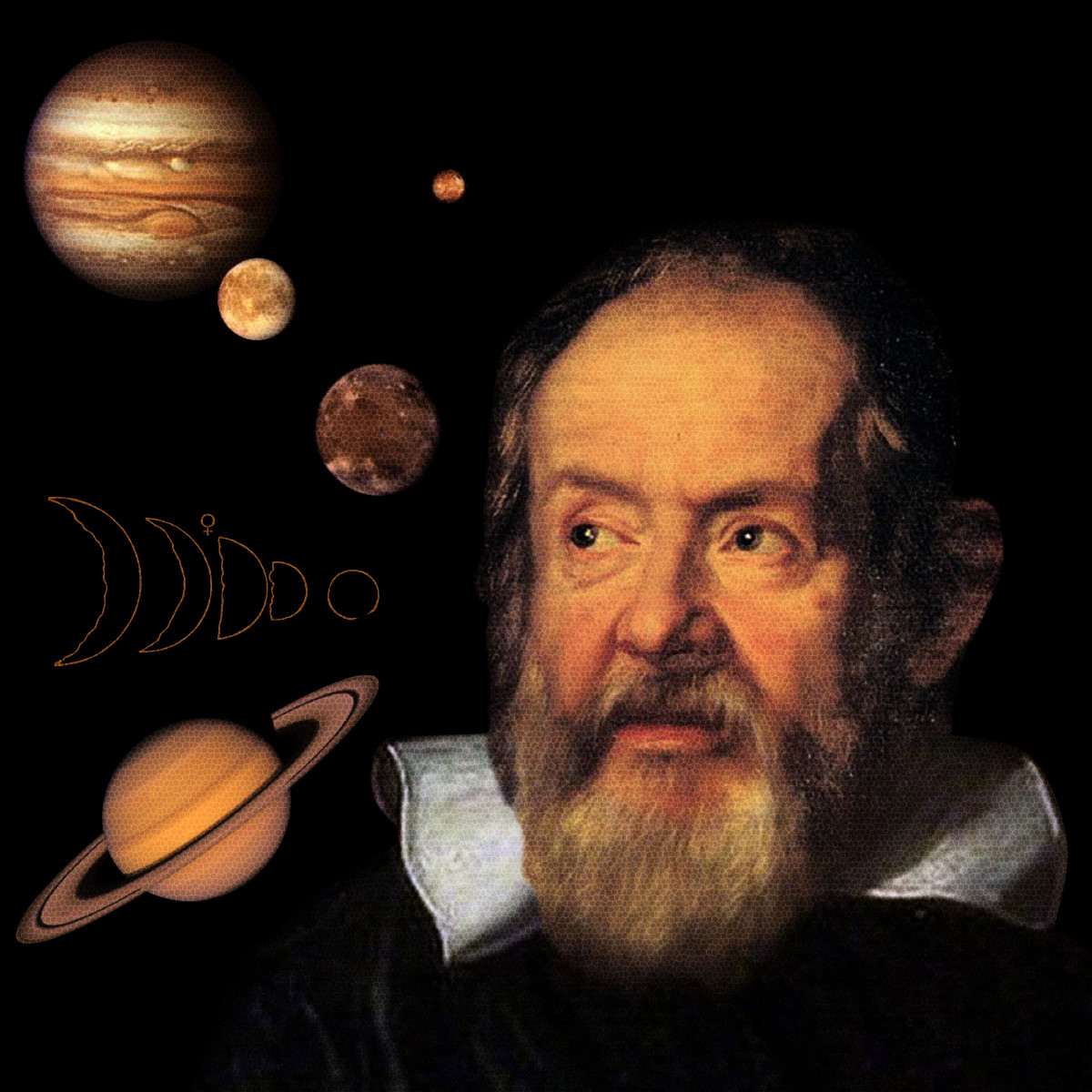Galaxies Imaged by the Hubble Space Telescope
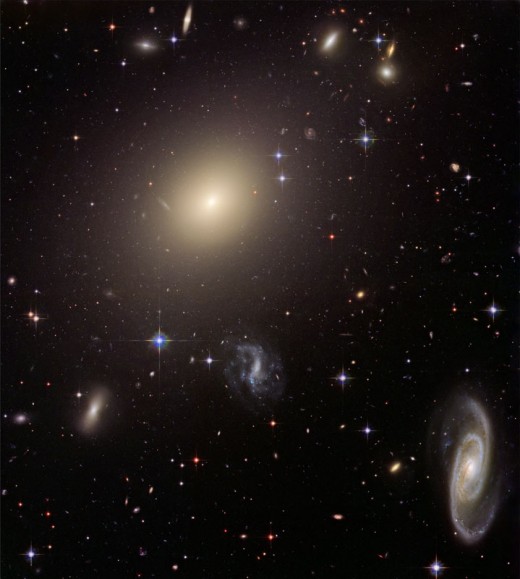

What is a Galaxy?
A galaxy is a system of an enormous collection of stars – up to a trillion or more individual stars or suns, dust and gas held together by gravity. Each galaxy belongs to a larger cluster or supercluster.
The bottom picture to the right is 6,500 light-years away in the constellation Ursa Major. 1,500 galaxies are visible in this image which covers an area of sky only about the width of a dime viewed from 75 feet away.
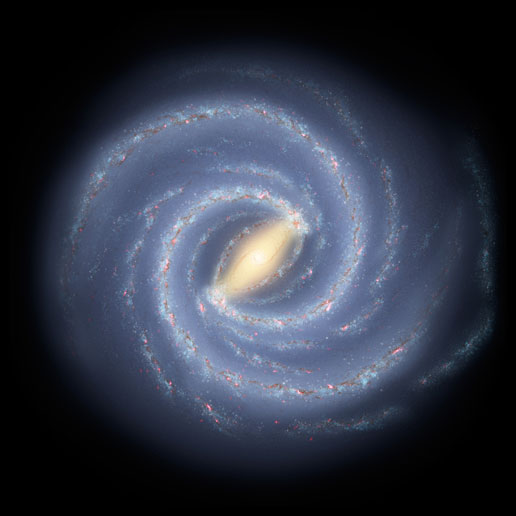
The Milky Way Galaxy is the home of our Solar System together with at least 200 billion other stars (more recent estimates have given numbers around 400 billion) and their planets, and thousands of star clusters and nebulae. As a galaxy, the Milky Way is actually a giant. Its mass is probably between 750 billion and one trillion solar masses (the mass of our sun is considered one solar mass. This is used as a standard to compare masses with other stars and galaxies) and its diameter is about 100,000 light years (a light year is the distance that a particle of light (a photon) will travel in a year — about 10 trillion kilometers or 6 trillion miles).
Edwin Hubble, the namesake of the Hubble Space Telescope, created a classification system that forms the basis of the one astronomers use today.
Types of Galaxies
Ellipticals
Elliptical galaxies are the largest group. They are smooth and featureless and contain hundreds of millions to trillions of stars. Their overall yellowish color comes from the aging stars and because they do not contain much cool gas, they no longer can make new stars. They come in varying degrees of roundness from E0 which are spherical to E7 which look like a lens. Both the largest, such as M87 in the Virgo Cluster and the smallest known galaxies are elliptical. Giant ellipticals are rare but dwarf ellipticals are the most common in the universe. Most revolve around larger galaxies.
Elliptical Galaxy NGC 1132
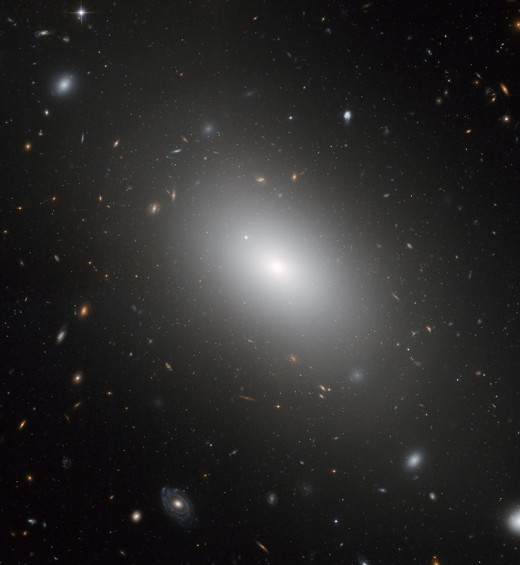
Located 318 million light-years away in the constellation Eridanus.
Elliptical Galaxy The Dusty Galaxy NGC 1316
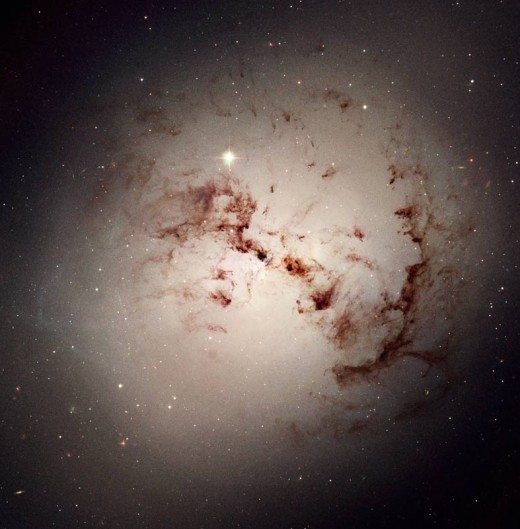
This galaxy is roughly 75 million light-years away in the constellation Fornax.
Spiral Galaxies
Spiral galaxies look like a flat disk with a central bulge which contains most of the stars. These are the older stars. The younger stars and star forming regions make up the spiral arms. There are different classifications of spiral galaxies. Barred Spirals have a bar structure in their center and the major arms come off the two ends of the bar. Some Spirals have tightly wound arms such as the Sombrero. Others have very pronounced arms or loose arms.
Barred Spiral Galaxy NGC 1300
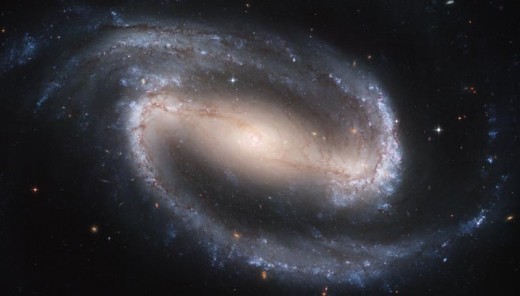
This one is 69 million light-years away in the constellation Eridanus.
Barred Spiral Galaxy NGC 1512
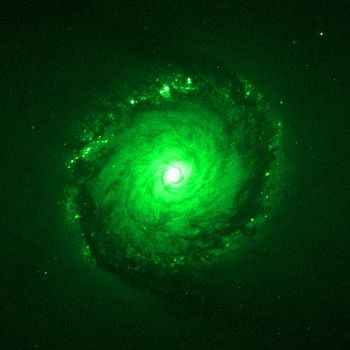
This is 6,500 light-years away in the constellation Horologium. The galaxy is 70,000 light-years across.
It is a little hard to see the arms coming off because the picture is a little dark but if you look close you may see them.
Barred Spiral Galaxy NGC 6217
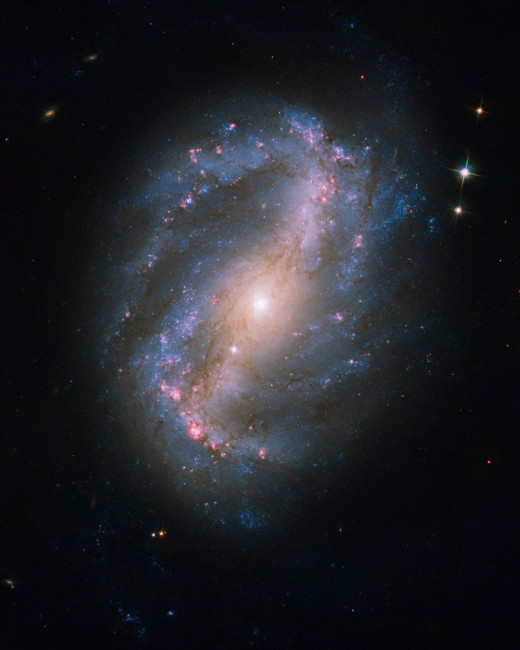
This is located 60 million light-years away in the constellation Ursa Minor.
Spiral Galaxy M100 NGC 4321
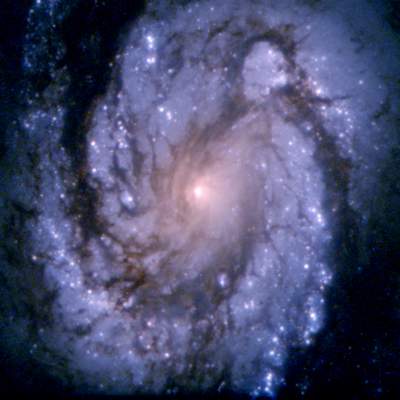
This is located 60 million light-years away in the constellation Coma Berenices. This is just a shot of the center of this galaxy.
Dusty Spiral Galaxy NGC 4414
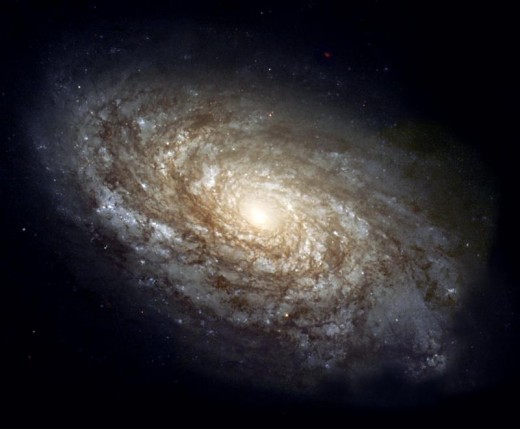
This is 62 million light-years away in the constellation Coma Berenices.
Spiral Galaxy The Whirlpool Galaxy M51 NGC 5194
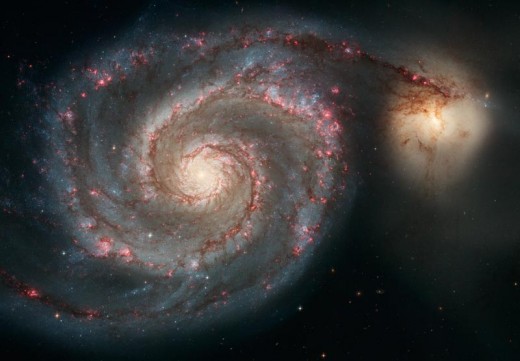
This is located about 31 million light-years away in the constellation Canes Venatici. It has as smaller companion galaxy to the right.
Heart of the Whirlpool Galaxy
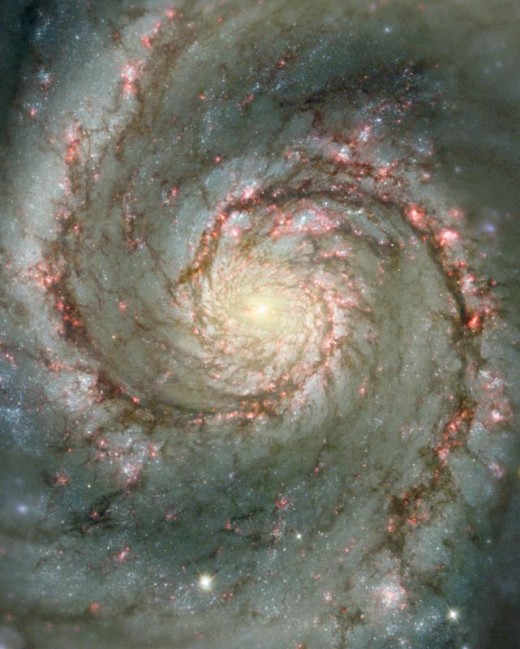
This image of the center of the Whirlpool Galaxy shows visible light from starlight, and light from the emission of hydrogen.
Spiral Galaxy NGC 3370

This galaxy lies about 100 million light-years away toward the direction of the constellation Leo. It was home to a supernova that appeared in 1994.
Spiral Galaxy The Sombrero Galaxy M104 NGC 4594
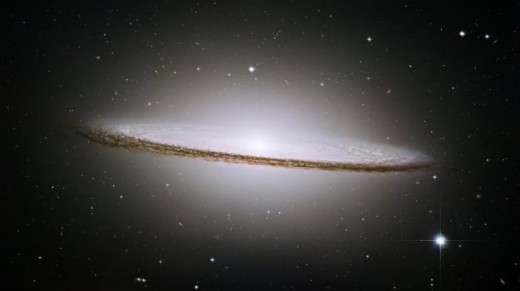
A brilliant white core is encircled by thick dust lanes in this spiral galaxy, seen edge-on. The galaxy is 50,000 light-years across and 28 million light years from Earth in the constellation Virgo.
Warped Edge-on Spiral Galaxy ESO 510-G13
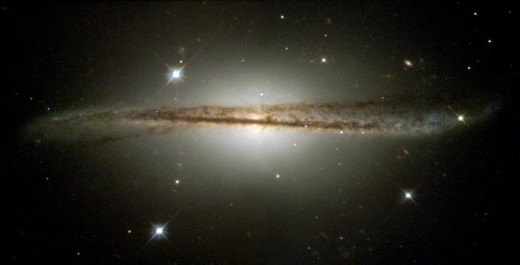
The dust and spiral arms of normal spiral galaxies appear flat when viewed edge-on. This galaxy has an unusual twisted disk structure which indicates it has been in a recent collision with another galaxy and is in the process of swallowing it. It was first seen in ground-based photographs from the European Southern Observatory (ESO) in Chile. ESO 510-G13 lies in the southern constellation Hydra about 150 million light-years from Earth.
Spiral Galaxy NGC 4622
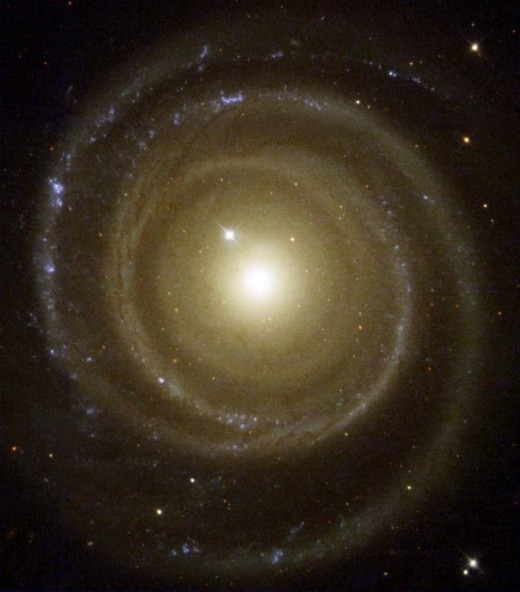
Most spiral galaxies have arms of gas and stars that trail behind as they turn. But this galaxy has two leading outer arms that point toward the direction of the galaxy's clockwise rotation. NGC 4622 also has a trailing inner arm that is wrapped around the galaxy in the opposite direction it is rotating. NGC 4622 is a rare example of a spiral galaxy with arms pointing in opposite directions.
Irregular Galaxies
These are galaxies that do not fall into the other classes.
Polar Ring Galaxy NGC 4650A
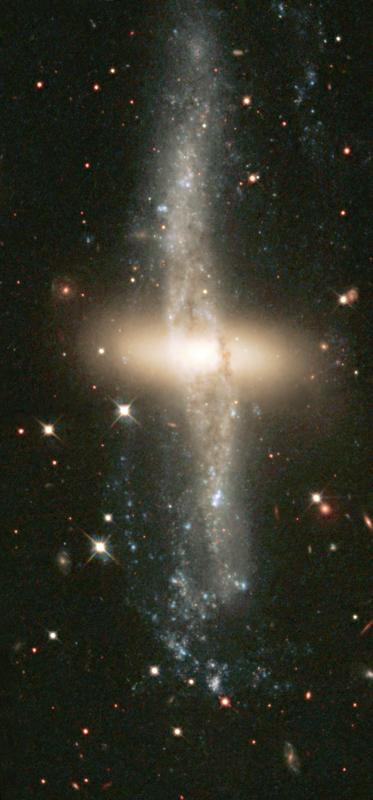
NGC 4650A is one of only 100 known polar-ring galaxies. Their unusual disk-ring structure is not yet fully understood. Located 130 million light-years away in the constellation Centaurus.
Starburst Galaxy The Cigar Galaxy M82 NGC 3034
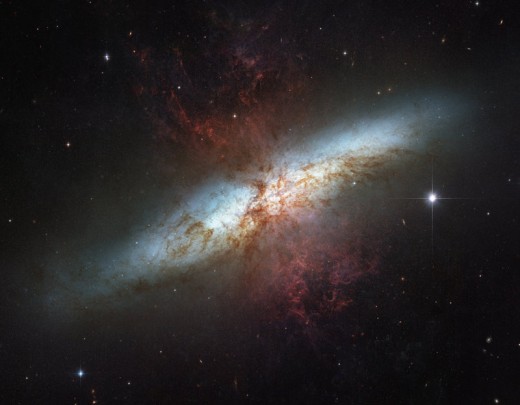
This is a starburst galaxy 12 million miles away in the constellation Ursa Major. These types of galaxies have a high rate of star formation. Throughout the galaxy's center, young stars are being born 10 times faster than they are inside our entire Milky Way Galaxy.
Ring Galaxy The Cartwheel Galaxy
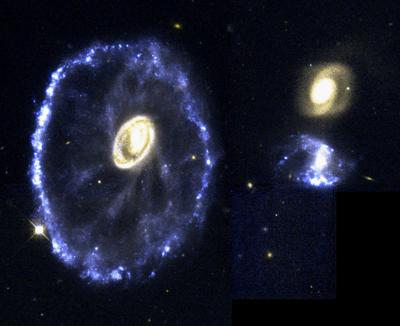
A rare head-on collision between two galaxies created this ring galaxy. It is a true-color image and is located 500 million light-years away in the constellation Sculptor.
The right side is a picture of just the core and a piece of the ring.
Ring Galaxy Hoag’s Object Galaxy
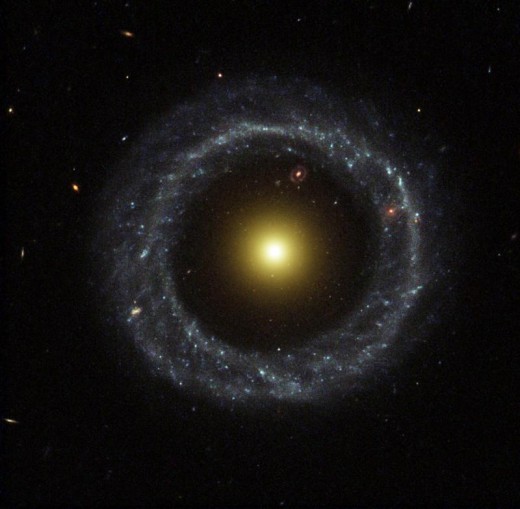
Another ring galaxy with a near perfect ring of hot, blue stars pinwheels about the yellow nucleus. The galaxy is 600 million light-years away in the constellation Serpens. This unusual galaxy was discovered in 1950 by astronomer Art Hoag. Hoag, hence the name.
There is another small object that looks similar to the upper right of the yellow core.
Sagittarius Irregular Dwarf Galaxy
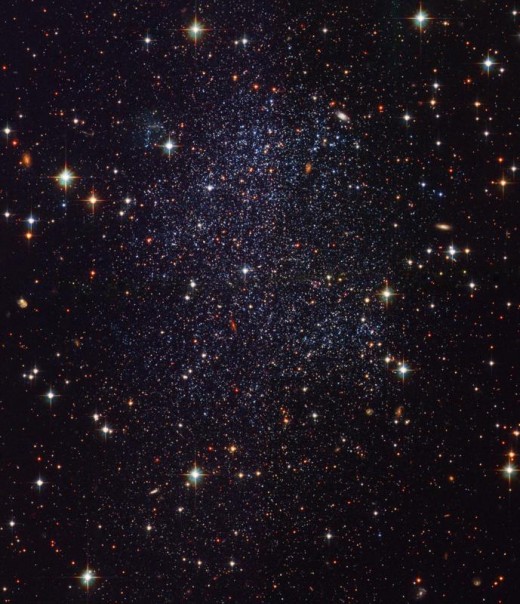
This is a small galaxy that is too close to The Milky Way and is beginning to be absorbed into our galaxy.
Galaxy Interactions and Mergers
Interactions of galaxies with each other, and even the merger of two galaxies into one are very common in the Universe. These interacting systems often form long tails of gas and stars. During the merger, the gas in each galaxy flows to the galaxy centers, becomes very dense, and forms stars at an accelerated rate. Merging galaxies are very bright, such as Arp 220 and are among the most luminous objects in the local Universe. Galaxy merging doesn't only happen between two large galaxies: in fact, most large galaxies are constantly swallowing up the smaller, dwarf galaxies that surround them. Our Milky Way is currently ripping apart our nearest neighbor, the Sagittarius Dwarf.
Antennae Galaxies NGC 4038 & 4039
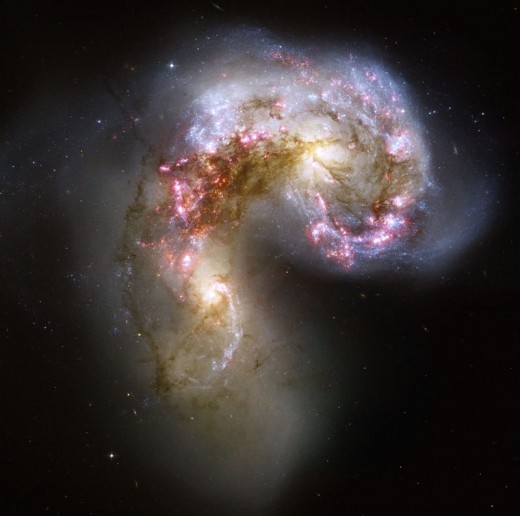
These two spiral galaxies were drawn together by gravity. They started to interact a few hundred million years ago. They are the nearest and youngest example of a pair of colliding galaxies. They are located 62 million light-years away in the constellation Corvus.
NGC 2207 & IC2163
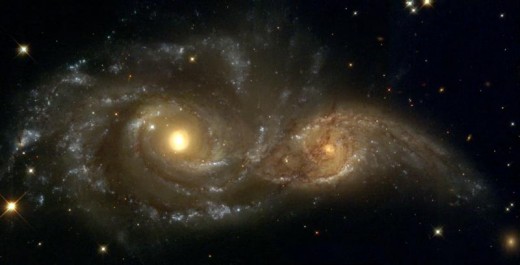
In the direction of the constellation Canis Major, two spiral galaxies pass by each other. The larger and more massive galaxy is cataloged as NGC 2207 on the left and the smaller one on the right is IC 2163. Trapped in their mutual orbit around each other, these two galaxies will continue to distort and disrupt each other. Eventually, billions of years from now, they will merge into a single, more massive galaxy.
Arp 220
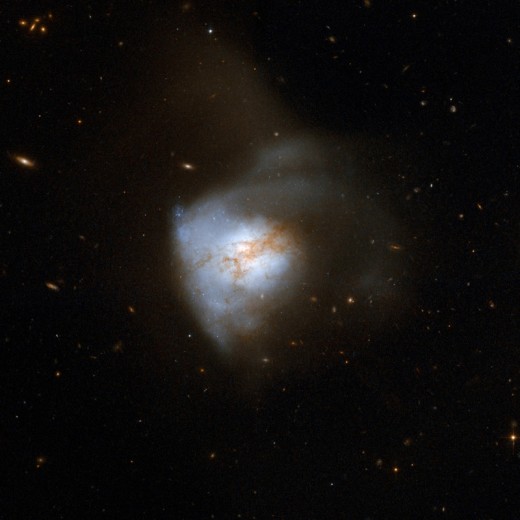
Arp 220 appears to be a single, odd-looking galaxy, but is in fact a nearby example of the aftermath of a collision between two spiral galaxies. It is the brightest of the three galactic mergers closest to Earth, about 250 million light-years away in the constellation of Serpens, the Serpent.
Stephan’s Quintet
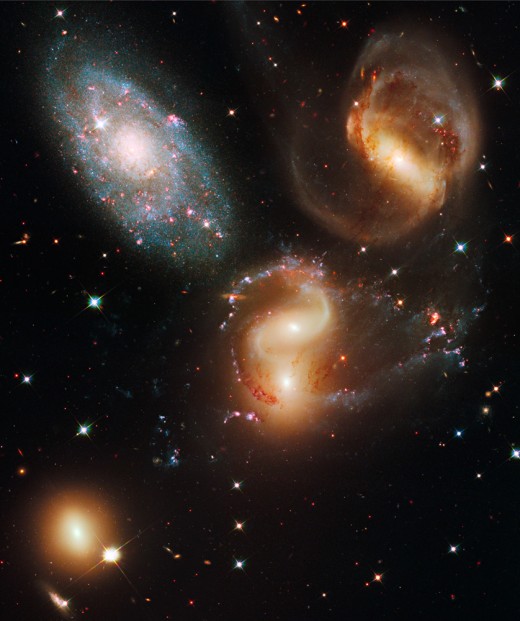
Stephan's Quintet is a group of five galaxies. The name, however, is a bit of a misnomer. Studies have shown that group member NGC 7320, at upper left, is actually a foreground galaxy about seven times closer to Earth than the rest of the group. NGC 7319, at top right, is a barred spiral. Continuing clockwise, the next galaxy appears to have two cores, but it is actually two galaxies, NGC 7318A and NGC 7318B. NGC 7317, at bottom left, is a normal-looking elliptical galaxy that is less affected by the interactions. Dwarf galaxy NGC 7320 is at the upper left. NGC 7320 is 40 million light-years from Earth. The other members of the quintet are located 290 million light-years away in the constellation Pegasus.
Blows the Mind
The Hubble Space Telescope estimates there are hundreds of billions of galaxies out there and with each one home to up to a trillion or more stars; the numbers begin to go beyond comprehension. It makes one feel very insignificant.
More Hubble Images
- Planetary Nebulae Imaged by the Hubble Space Telescope
Planetary Nebula is a huge misnomer. It has nothing to do with planets. They are not visible through the naked eye. They were originally named in the 18th century when astronomers looking through the small...
Hubble Telescope and Galileo's Contribution
- The Hubble Space Telescope: Astronomers Eye in the Sky
Astronomers dreamed of a telescope in space or an eye in the sky for many decades. The Hubble Space Telescope was the result of those dreams. In 1973 NASA selected a team to design the telescope and its... - Galileo and the Telescope: How 400 Years Ago Galileo Changed the World
Galileo, an Italian professor of mathematics, did not invent the telescope. No one knows for sure who the first inventor was. But this new device spread quickly across Europe. At first it was more of a parlor...
Are You Out There?
- Calling All Intelligent Life Forms: Are You Out There?
This quote makes me laugh out loud. We are so intent on finding other intelligent life that we never stop to think that maybe they have already found us and do not consider us intelligent enough to...
Sources:
Astronomy Magazine Collector’s Edition – Hubble’s Greatest Pictures
Atronomy Magazine – 100 Most Spectacular Sky Wonders and How to See Them
www.hubblesite.org – the official website of the Hubble Space Telescope


